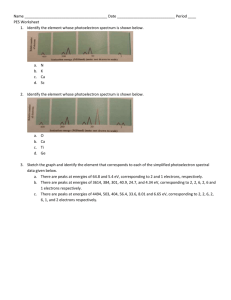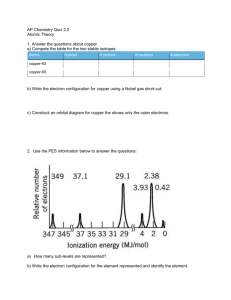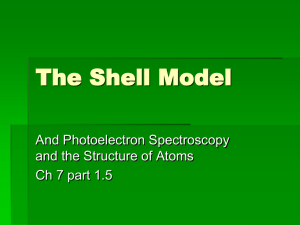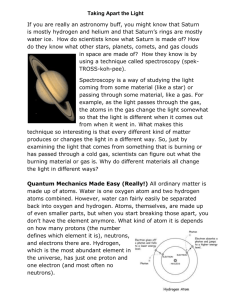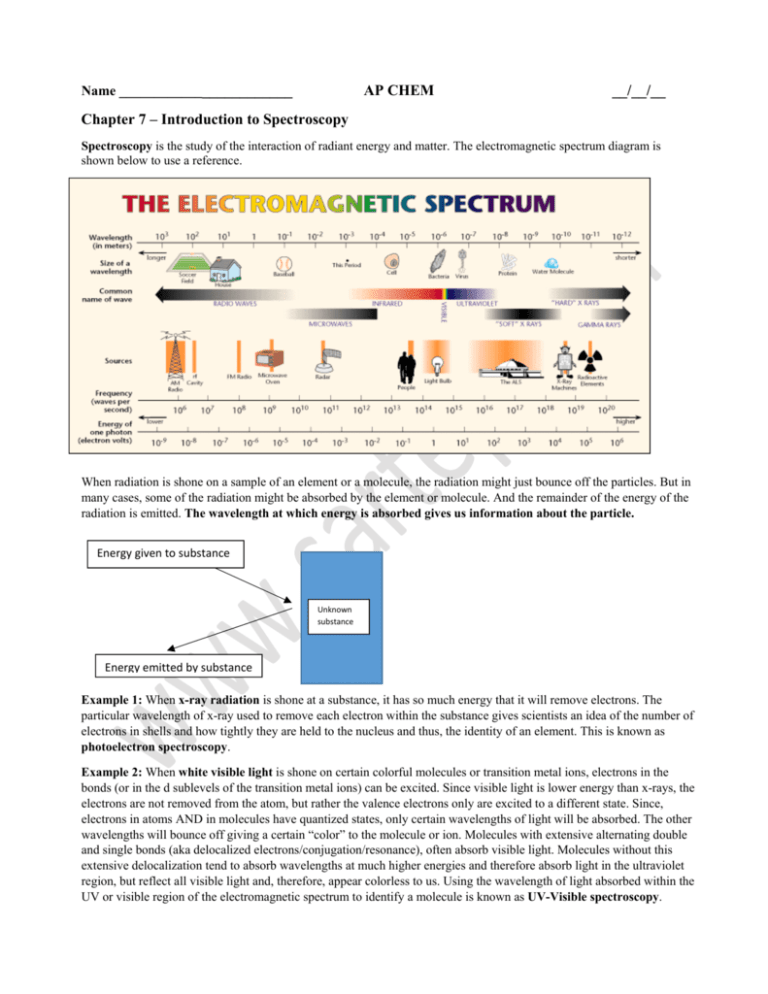
Name ________________________
AP CHEM
__/__/__
Chapter 7 – Introduction to Spectroscopy
Spectroscopy is the study of the interaction of radiant energy and matter. The electromagnetic spectrum diagram is
shown below to use a reference.
When radiation is shone on a sample of an element or a molecule, the radiation might just bounce off the particles. But in
many cases, some of the radiation might be absorbed by the element or molecule. And the remainder of the energy of the
radiation is emitted. The wavelength at which energy is absorbed gives us information about the particle.
Energy given to substance
Unknown substance Energy emitted by substance Example 1: When x-ray radiation is shone at a substance, it has so much energy that it will remove electrons. The
particular wavelength of x-ray used to remove each electron within the substance gives scientists an idea of the number of
electrons in shells and how tightly they are held to the nucleus and thus, the identity of an element. This is known as
photoelectron spectroscopy.
Example 2: When white visible light is shone on certain colorful molecules or transition metal ions, electrons in the
bonds (or in the d sublevels of the transition metal ions) can be excited. Since visible light is lower energy than x-rays, the
electrons are not removed from the atom, but rather the valence electrons only are excited to a different state. Since,
electrons in atoms AND in molecules have quantized states, only certain wavelengths of light will be absorbed. The other
wavelengths will bounce off giving a certain “color” to the molecule or ion. Molecules with extensive alternating double
and single bonds (aka delocalized electrons/conjugation/resonance), often absorb visible light. Molecules without this
extensive delocalization tend to absorb wavelengths at much higher energies and therefore absorb light in the ultraviolet
region, but reflect all visible light and, therefore, appear colorless to us. Using the wavelength of light absorbed within the
UV or visible region of the electromagnetic spectrum to identify a molecule is known as UV-Visible spectroscopy.
When white light is observed, what is actually being seen is all the colors of light combined.
When this light passes through a substance, certain energies (or colors) of light are absorbed
while the other color(s) are allowed to pass through or are reflected. This is why some
substances appear colored. The color we see is the combination of the energies of visible light
that are not absorbed by the sample. If the substance does not absorb any light, it appears
white or colorless. A solution appears a certain color due to the absorbance and transmittance
of visible light. For example, an orange solution appears orange because it is absorbing all of
the colors except orange. A sample may also appear orange
if all colors of light except blue are transmitted. This is
because blue and orange are complimentary colors. (see
figure below right)
violet
380–450 nm
blue
450–495 nm
green
495–570 nm
yellow
570–590 nm
orange
590–620 nm
red
620–750 nm
Chlorophyll, absorbs extensively at blue (~450 nm) and
orange-red (~650 nm) wavelengths and appears green to our
eyes
Beta-carotene, found in carrots, absorbs many wavelengths, especially at blue (~454 nm) and appears orange to our eyes.
Example 3: In the less energetic regions of the electromagnetic spectrum (infrared radiation and microwave radiation),
the radiation doesn’t have enough energy to excite electrons and certainly not enough to remove electrons. Instead, energy
at certain wavelengths of infrared or microwave can be absorbed and cause a particular bond in a molecule to have a
different vibrational state. Microwave ovens cook by causing water
molecules to rotate. However, since the wavelength is on the order of
millimeters, the water must be in objects at least that size. Ants and rice
are largely unaffected by microwaves because they’re too small.
We tend to think of bonds as being rigid, but in reality, the atoms and
electrons have a certain amount of kinetic energy. The atoms on either
side of a bond can bounce closer and further away from each other. If there are several bonds near each other in a
molecule, the atoms can even scissor. See this link for an animation of the above:
http://chemwiki.ucdavis.edu/Physical_Chemistry/Spectroscopy/Vibrational_Spectroscopy
Or another: https://www.youtube.com/watch?v=S8R30EdcIT4&feature=player_embedded
Each of these vibrations has a specific energy. Therefore, if the molecule switches from one vibrational state to another
state, a specific amount of energy is absorbed or released, and this is usually in the infrared region of the spectrum.
Further, the amount of energy absorbed depends on the order of the bonds and the atoms in the bonds. So, chemists can
measure at what wavelengths energy is absorbed and thus the region of the electromagnetic spectrum to determine what
types of bonds or functional groups are present. Carbon dioxide, absorbs energy at 4 micrometers and 15 micrometers (in
the infrared part of the spectrum), and does not allow these wavelengths to escape into space, effectively heating up our
atmosphere. Other greenhouse gases absorb different, specific wavelengths of infrared depending on their particular
molecular structure. Measuring the wavelengths that are absorbed within the infrared spectrum can help identify a
compound and/or determine its molecular structure and is known as infrared spectroscopy.
Summary: Types of Spectroscopy
Type of
Radiation Used
X-ray
Frequency
1016 – 1019 Hz
Relative
Energy
Quite High
What it does to the
atom/molecule
Removes core
electrons
Ultraviolet
1016 – 1019 Hz
High
Visible Light
1016 – 1019 Hz
Medium
Excites valence
electrons
Excites valence
electrons
Infrared
1016 – 1019 Hz
Low
Changes the
vibrations in the
bonds
Microwave
1016 – 1019 Hz
Quite Low
Changes the
rotations of the
atoms in the bonds
What it tells us about
the atom/molecule
How tightly the
electrons are held by the
nucleus Measures their
binding energy); the
identity of an element
The identity of a
molecule or element
The identity of
concentration of a
molecule
The types of
bonds/atoms/functional
groups within a
molecule
The locations of
hydrogen atoms within a
molecule
Name of
Spectroscopy
Photoelectron
spectroscopy
(PES)
UV-Visible
Spectroscopy
UV-Visible
Spectroscopy
IR (vibrational)
spectroscopy
Microwave
(rotational)
spectroscopy
Ideas to consider:
1. Our eyes are spectrophotometers. The colors we see can help us to understand the structures of the molecules we are
looking at. The colors we see are opposite on the color wheel to the colors being absorbed by the electrons.
2. Not many molecules absorb in the visible region of the electromagnetic spectrum, because it is such a narrow region of
the spectrum.
3. If we could “see” wavelengths outside of the visible spectrum, we would be able to “see” color from some molecules
that currently appear colorless to us. Indeed, some insects and birds can “see” different wavelengths of the ultraviolet
region and some reptiles can see wavelengths in the infrared region. This is because their eye structures contain different
molecules that are sensitive to different wavelengths. These animals do not “see” the world as we do!
4. By shining light of all types of wavelength on molecules, we can measure not just the visible light wavelengths they
absorb but also the wavelengths of other types of radiation we can’t see to figure out the structure of the molecule.
5. Why is the sky blue? O2 and N2 have a vibrational absorbance that is blue. The white light from the sun hits these
molecules, and blue light in particular is absorbed but then re-emitted/scattered. The other colors of the light have too low
of energy to interact with the O2 and N2 and aren’t scattered as much.
Photoelectron Spectroscopy (PES)
The Photoelectric Effect is the observation that photons short-wave (visible
or ultraviolet) light can cause it to emit electrons. This is an example of
ionization, with the photons providing the ionization energy. When visible or
ultraviolet light is shone on a substance, the energy from the photons of light
excites electrons in the substance. If the energy exceeds the ionization energy of
an atom in the substance, the electron is emitted. The emitted electrons are called
photoelectrons.
Photoelectron Spectroscopy or photoemission spectroscopy (PES) involves
using the energy from electrons emitted via the photoelectric effect to gain information about the electronic
structure of a substance. The term “photoelectron spectroscopy” is generally used for the technique when applied to
gases, and “photoemission spectroscopy” is generally used for electrons emitted from solid surfaces. In photoelectron (or
photoemission) spectroscopy, a substance is bombarded with photons, which have a given amount of energy based on
their frequency: Ephoton = hν
By measuring the kinetic energy of the emitted electron, Ek, and predetermining the “work function”, Wo, of the substance
(the amount of additional energy it takes to move the delocalized electron to the surface of the material—zero for gases,
but nonzero for solids), we can calculate the binding energy, EB, of the electron from Einstein’s equation for the
photoelectric effect: Ek = hν – EB – W0
The photons used for photoelectron spectroscopy range from ultraviolet light to X-rays. Ultraviolet photoelectron
spectroscopy (UPS) and extreme ultraviolet photoelectron spectroscopy (EUPS) are used to study valence electrons and
the electrons that participate in chemical bonding. X-ray photoelectron spectroscopy (XPS) is most often used to study
core electrons, particularly in solids.
Interpreting Photoelectron Spectra
The XPS spectrum for gold looks like the following:
Notice that the peaks
for 4s, 4p, 4d, and 4f
are different heights.
The height of the peak
is proportional to the
number of electrons in
a given sublevel.
Analysis of UV photoelectron spectra for a single element with a relatively low atomic number is straightforward. For
example, the following is an idealized plot of the photoelectron spectrum for lithium: 1s2 2s1
The x -axis has units of binding energy of the electron,
usually electron-volts (eV). Recall that electrons in
higher sublevels have less binding energy, which makes
them easier to remove. This means the peak at the right
corresponds with the easiest-to-remove electrons (for
lithium, this is the 2s electron). The peak at the left
corresponds with the electrons that are hardest to remove
(for lithium, these are the two 1s electrons).
The y -axis indicates the number of photons emitted with
that energy. This means the height of each peak is
proportional to the number of electrons in the
corresponding sub-level. Notice that the peak at 6.26 eV (the 1s electrons) is twice as high as the peak at 0.52 eV (the 2s
electron). This means there are twice as many electrons in the 1s sublevel as in the 2s sublevel. The only element that
matches this spectrum is lithium (1s2 2s1).
You try: 1. Below is the PES of sulfur, and a table of successive ionization energies. The energy scale for the PES is in
MJ/mol (1 MJ = 1000 kJ). There is exactly one peak on this graph whose energy corresponds to an ionization energy in
table 7.2. What is it? Why doesn't anything else match up?
(From Brown et al.,
Chemistry the Central
Science 12 ed., copyright
Pearson Prentice Hall)
2. Identify the element represented by the PES
spectrum shown to the right.
3. Here is a PES spectrum of boron (Z=5; blue) superimposed on that of fluorine (Z=9; pink)
a. Why are the fluorine peaks to the left of the boron peaks?
b. Why is there one peak in fluorine that is so much taller than all the others?
4. Below is shown the PES spectrum of sulfur (atomic number = 16).
a. Write the full electron configuration of sulfur.
b. Label each peak in the spectrum to show which subshell it represents (i.e., 1s, 2s, etc.)
c. On the spectrum, sketch in the relative locations and correct peak heights for the spectrum of aluminum (atomic
number = 13). By relative location, I mean correctly to the left or right of the same subshell peak in the sulfur spectrum.
d. Draw a circle around the sulfur peak whose energy is equal to the first ionization energy of sulfur.
5. The photoelectron spectra above show the energy
required to remove a 1s electron from a nitrogen atom
and from an oxygen atom. Which of the following
statements best accounts for the peak in the upper
spectrum being to the right of the peak in the lower
spectrum?
(A) Nitrogen atoms have a half-filled p subshell.
(B) There are more electron-electron repulsions in
oxygen atoms than in nitrogen atoms.
(C) Electrons in the p subshell of oxygen atoms
provide more shielding than electrons in the p
subshell of nitrogen atoms.
(D) Nitrogen atoms have a smaller nuclear charge
than oxygen atoms.
(E) Oxygen atoms are smaller than nitrogen atoms.
Answer 1: The first ionization energy of sulfur matches the furthest‐right peak on the PES. The different peaks in PES represent the effort needed to evict an electron in different subshells of a neutral sulfur atom. In contrast, the ionization energy chart represents the energy needed to evict the most easily removed electron from a neutral sulfur atom (IE1), an S+ ion (IE2), an S2+ ion (IE3), etc. These two data sets have only one point of overlap, which is IE1 on the chart and the lowest‐energy peak on the PES. None of the peaks in the PES relate to removing an electron from a sulfur cation, and, likewise, none of the successive ionization energies concern removing an electron from other than the highest subshell. Answer 2: Carbon Answer 3: a. Why are the fluorine peaks to the left of the boron peaks? Answer: Fluorine has a greater nuclear charge, causing the electrons in all the subshells to be held more tightly. b. Why is there one peak in fluorine that is so much taller than all the others? Fluorine has 4 more electrons than boron; all the additional electrons are in the 2p subshell, giving it 5 in all, causing that peak to be much higher than 1s or 2s, which each have 2 electrons. Answer 4: Below is shown the PES spectrum of sulfur (atomic number = 16). a. Write the full electron configuration of sulfur. 1s2 2s2 2p6 3s2 3p4 b. Label each peak in the spectrum to show which subshell it represents (i.e., 1s, 2s, etc.) They go in order from left to right as written in the electron configuration above. c. On the spectrum, sketch in the relative locations and correct peak heights for the spectrum of aluminum (atomic number = 13). By relative location, I mean correctly to the left or right of the same subshell peak in the sulfur spectrum. All the aluminum peaks should be shifted to the right relative to the same peak in sulfur because aluminum has a smaller nuclear charge. The heights should all be the same as in sulfur, except the 3p peak, which should be half the height of the 1s, 2s, and 3s peaks. d. Draw a circle around the sulfur peak whose energy is equal to the first ionization energy of sulfur. It's the 3p peak. Answer 5: D Nitrogen atoms have a smaller nuclear charge than oxygen atoms.

